William Kent,
The Sphinx of Durham
In 1966, the annual exhibition at the Whitney Museum of American Art featured the leading artists of the Pop Art movement. Sixty-six of them were printmakers, including Jim Dine, Jasper Johns, Robert Rauschenberg, Larry Rivers, and James Rosenquist. Neither the Whitney’s directors nor any of the artists knew that exhibiting in their midst was an Outsider, a completely self-taught artist — William Kent. Indeed, he was the only self-taught artist in the entire exhibition. Kent’s Leave the Moon Alone! was illustrated in the Whitney’s exhibition catalogue. However, he steadfastly defied being categorized as a Pop artist. “I never studied art,” he stated impassively. “If I had I wouldn’t be doing this kind of work. Some professor would have told me the ‘right’ way to do art.”
That year Lucy Lippard illustrated one of his prints in her seminal book, Pop Art. She noted that although Kent had used popular images for years, his work was not like that of the Pop artists because his images were “strongly satirical.” The print historian Fritz Eichenberg was so impressed with Kent’s invention of the slate print that he described it as a new medium in his chapter on relief prints in his classic opus, The Art of the Print (1976).

Kent was born in Kansas City, Missouri, in 1919. As a boy growing up during the Great Depression, he recalled that his father had some schooling but “never had a decent job” and the family suffered. However, his father managed to buy an upright piano for a few dollars; and, after a series of free piano lessons his young son immediately fell in love with making music. A few years later, the boy had saved enough money to pay “Miss Peach” fifty cents a lesson. He was soon playing opera scores. An avid reader, by sixteen he had read James Joyce’s Ulysses, and was placed in the accelerated classes in his high school, which allowed him to earn college credits.
In 1940 Kent was drafted into the U.S. Navy, and served at the Naval Station at Great Lakes as a storekeeper. In 1942 he entered Northwestern University but upon graduating in 1944 was left “completely unstimulated by the experience.” However, the rich cultural life of Chicago with concerts, museums, and visiting performances by the Ballets Russes and the Metropolitan Opera opened new worlds for him. Returning to his love of music, and using the G.I. Bill, he entered the graduate program for music theory and composition at the Yale University School of Music. He was greatly encouraged by Paul Hindemith, the modernist German composer and theorist who had fled to the United States in 1940 because the Nazis had deemed his work “degenerate.” During this period Kent made many friends from the Yale Art School and came into intimate contact with their sculpture, painting, and printmaking. Soon, Kent was experimenting on his own with sculpture, painting, and photography.
Upon graduating from Yale in 1947, Kent quickly discovered that there were no jobs for a musician immersed in theory and composition, and he had no contacts in the field. However, he remained in New Haven thanks to the kindness of the Dean of the Yale Medical School, Milton C. Winternitz, who invited him to live in the basement of his home and set up a studio there. It was during Kent’s studies in music theory and composition that he came to experience what he called “the visualization of sound” and he now began to express this sense by carving in stone and marble and experimenting in plaster, clay, and cast stone. In the tradition of the Chinese he also appreciated unique pieces of driftwood as sculpture and placed a series on bases. By 1948 his transition to the fine arts had crystallized. When asked to describe his transition from music, he was evasive. “There is no reason for it. It just happened.” The same answer was provided if one asked him to explain the genesis of any of his works. “It just is,” he would inevitably quip.
One catalyst was likely that great patroness of the avant-garde and founder of the Société Anonyme, Katherine S. Dreier [1887-1952]. To Kent’s good fortune, Dean Winternitz introduced him to her in 1948 when Duchamp was helping her create a catalog of her collection. She invited Kent to visit at her home in Milford and bring along several of his abstract painted bas-relief plasters. She greatly admired and purchased one. Kent respected her and regretted that was the only time he visited her. Ultimately, she bequeathed her collection to Yale.1

In 1949 Kent was offered another basement studio next door, this time with Prof. Charles Walker, head of Yale’s Institute of Human Relations. Kent took a job at Yale’s printing shop where he learned how to use the offset lithography presses. In off hours, he experimented with the projectors, magnifying images from newspapers and burning images into the photo-sensitized aluminum printing plates. The job would eventually inspire him to begin publishing. During his off hours at Yale’s printing office, he used the printing equipment to publish his first book, William Kent: Stonecarvings, 1951-1955, illustrating his limestone and marble sculptures of cubist heads and small animals. In his sardonic wit, he named his imprint Philistine Press, and he was soon collaborating with his two closest artist friends, William Skardon [1923-1983] and David T.S. Jones [1925-1996] to produce a series of books and newsletters.
In the early 1950s Kent, Skarden, and Jones and other artists became part of a vibrant group of graduates from the Yale School of Art, the Yale School of Music, and the Yale Repertory Theater who formed what became a vibrant artists’ colony in Westbrook, Connecticut. The center of their activities was the Westbrook Gallery, an old icehouse by a pond on the old Boston Post Road that had been purchased by the painter-sculptor Aage Hogfeldt. The group held exhibitions of painting and sculpture, presented modern dance and plays, and performed chamber music. These highly accomplished artists remain little-known today, largely because most shared Kent’s anti-commercial spirit for eschewing promotion. Their center was made even more extraordinary when Hogfeldt built what he described as “the world’s only 3-position camera obscura.” Viewers were invited to ascend a magnificent spiral staircase made from industrial wooden pallets, bolted together and suspended by aircraft cable. Having climbed the top, one entered into the loft camera box, which turned on a revolving mirrored turret. The surrounding aerial view was reflected down to the gallery floor below as a motion picture on an eight-foot circular tabletop. The same pictures could be seen on a fine screen stretched high above the circular table. In 1954, Kent collaborated with Jones to create the first of several “Slideoperas,” which were presented within the main gallery. Their performances, such as The Philistine Traveler, integrated music, poetry, and moving paintings.
Between 1947 and 1963 Kent carved more than 340 works whose zoomorphic subjects reflected his fascination with the natural world. Nearly one hundred of these sculptures were wooden bowls inspired by African and Pre-Columbian carving and shaped as insects, reptiles, birds, and fish. In the early 1950s he began carving his creatures in bas-relief on one-inch thick slate flagstones. The process was arduous and time-consuming, especially since the small stone-cutting chisels do not have wooden handles like those for woodcarving. The resulting bas-relief slates appear to be modernist fossils. From 1960 to 1964, he carved some large sculptures that for the first time expressed political or social themes such as Portrait of the Artist Self-Crucified (1960, 64 inches tall) and Monkey with Mortarboard (1961, 87 inches tall) — a spoof on Yale education.
In 1957, under the sponsorship of Prof. Walker, Kent won a grant from the Demarest Trust, which helped him to continue his focus on sculpture. The next year he further experimented with his slate bas-reliefs by applying ink of various colors on different sections of the slate image. He inked all of the colors at once, then placed a piece of dampened rice paper on top, carefully applied pressure with a shaving brush or small brayer to impress the pigment to its ground, and finally pulled off the paper to reveal the final unique image.

The biggest change came in 1963 while he was exploring the inventory of a demolition company and was surprised to find a supply of old slate blackboards from a school — many of which measured 42 by 72 inches and 3/8-inch thick and weighed 200 pounds. Soon he was carving enormous bas-reliefs. But because it proved too difficult and expensive to find oversize sheets of rice paper to match these large slates, within a year he turned to printing almost exclusively on fabric, mainly on Indian Head cotton (either plain or with period patterns), a high gloss acetate satin, and a low luster peau de soie satin. Moreover, the large format elicited another change. Kent now marshaled his full creative vision upon the societal subjects that would hereafter serve as the victims of his acerbic wit — or venom: politics, sex, violence, corruption, environmental issues, race riots, and a senseless Vietnam War.

In 1961, he was hired as the first curator of the newly founded John Slade Ely House in New Haven, which was dedicated to exhibiting works by contemporary artists. It was also home to the New Haven Paint & Clay Club, established in 1900. Here he was able to set up a studio and continue his carving. In 1962, Walter Chrysler purchased Kent’s Nature Lover No.4, Reclining with Caterpillar & Acrobatic Grasshopper — a monumental carving that defies neat categorization — from Gallery 64 in the East Village in New York. Kent rejected the notion that it was grounded in surrealism. The exhibition also caught the eye of Richard Castellane, a pioneering art dealer who promoted artists who were parallel to the Pop artists but conjuring their own unique takes on conceptualism, minimalism, the psychedelic, and even earthworks. Notably, he is credited with being the first dealer to discover and promote two other highly original and idiosyncratic artists, Yayoi Kusama [b.1929] and Robert Smithson [1938-1973]. Castellane was drawn to Kent’s monoprints and his large wood sculptures. For the next four years he mounted solo exhibitions for Kent at his Castellane Gallery on Madison Avenue. Consequently, Kent’s large slate prints and sculptures attracted museum curators who exhibited them at the Wadsworth Atheneum in 1963, the Pennsylvania Academy of the Fine Arts in 1964, the DeCordova Museum in 1964 (and again in 1966), the Brooklyn Museum’s 15th Annual Print Exhibition in 1964), and the Whitney Museum’s aforementioned annual in 1966.

At first glance it is easy to fall into the trap of categorizing Kent with the seminal Pop artists. After all, his images and objects are adopted from popular culture. But a deeper look proves that both conceptually and technically his work is distinguished from that movement, and particularly from that of Andy Warhol, the “King of Pop Art.” Kent’s only common ground with Warhol was that they shared the concept of the “monoprint-as-painting” by using a fabric support. Both Warhol and Kent used oil-based inks on various fabrics but Warhol more often used acrylic pigments over a gesso ground. Warhol left production entirely to a team of master printers to create the negative photographic master silkscreen and then use squeegees to force the acrylics through that screen. A different screen was used for each new color and the various impressions had to be registered. In contrast, Kent produced his monoprints and paintings entirely by himself, starting with carving the slates and then moving the large and heavy matrix into place for printing. For more complex imagery such as lace patterns he created a rubber stencil, which he glued to the slate and then sandblasted away the negative space. He applied all of the oil-based inks (often Day-Glo from Sinclair & Valentine) on the slate at one time. Then, with the fabric rolled around a cardboard tube he would slowly roll the fabric onto the ink-covered slate. Finally, using a hand-held brayer he pressed the material onto the inked slate. After the material had absorbed the ink he slowly lifted the final piece off and hung it to dry. During the long process he worked completely alone without assistants or a mechanical press.
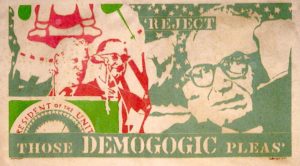
In 1963 Castellane urged Kent to adopt the marketing strategy of printing in limited editions. For the smaller prints on rice paper he typically produced no more than twenty or thirty prints. However, the intended edition number was usually never realized because in part, Kent, unlike Warhol, was averse to mass marketing. He soon discontinued the practice of editions, delighting instead in producing a series of monoprints where each one had a unique combination of oil pigments, fabric color, or pattern. He sometimes produced twelve to fifteen monoprints of these larger slate paintings on fabric. Kent would typically recoil whenever asked if he was influenced by his peer, Andy Warhol. His first reaction would be to declare, “I was never aware of Warhol. He had no influence upon me. In the early 1960s he was not really a known figure.” He would then add, “It’s the New York art establishment that turned Warhol and other Pop artists into gods. “But I call them the fashionable interior decorators of our time.” One of Kent’s few similarities with Warhol is that his monoprints on fabric are viewed as paintings whereas his images imprinted on paper are designated as prints. Warhol was drawn to screenprints because they evoked “an assembly line effect” whereas Kent produced monoprints precisely because he felt each work should be a unique expression.
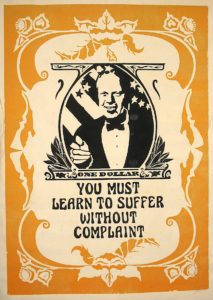
Kent was as much an art historian and philosopher as he was a musical theorist and composer. It is not surprising that he expressed his alignment with William Blake who two hundred years earlier had written of the cultural pitfall of creating vapid images and then widely commoditizing them for a booming lot of ignorant philistine consumers. From 1958 to 1976 Kent painstakingly produced 147 different slate masters. And from each of these masters he produced a series of monoprints that differed according to their colors and ground supports (rice paper or fabric). Toward the end of this printing period he carved a number of small slates that could be moved around on the fabric for even more varied composite images.
In an essay for a 1997 exhibition of Kent’s prints at Colgate University, art historian Robert McVaugh offered an overview of Kent’s place in the world of Pop Art:
It is tempting to approach the prints of William Kent as an intriguing development within Pop Art. The dates are right, and the presence of prints such as We Want You! in important exhibitions and publications devoted to Pop Art suggests a firm pedigree. Yet any efforts to pigeon-hole Kent as a representative of Pop ultimately proves more constricting than illuminating. His prints are not in their essence either about style, about art, or about popular culture. Instead Kent’s prints reflect the frustration of an artist acutely aware of the disjunction between his fundamentally Romantic vision of the world and the socio-political order of his time.
— Robert McVaugh, Pop Art with Social Pop: Slate Prints by William Kent
(The Picker Art Gallery, Colgate University, Nov 1997)
Ultimately, Kent’s images stood apart from the young Pop Art movement as much as they were first welcomed by it. A closer look at the subject matter and intent of Andy Warhol’s work offers some insights on why “idiosyncratic” seemed to be the most appropriate label to attach to Kent.
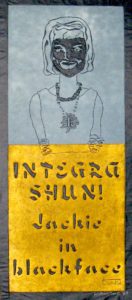
In 1963 Warhol produced $1.57 Giant Size, drawn from a supermarket’s flyer. It was his first and only screenprint edition of that year. That year Kent produced fifteen different images also of popular culture appropriated from newspapers and magazines. But the two artists were conceptually far apart. Warhol was drawn to glorifying everyday objects and even more enchanted by celebrities. Kent was also drawn to everyday objects but his images reflect an angry intellectual whose combination of images and words — ignited by colors, shapes, and forms — regaled against that popular culture.
Kent’s Integrashun! Jackie in Blackface of 1963, produced just before the assassination of President Kennedy is a stinging indictment of racial inequality and stereotypical views held by the upper class. In a variant of that image Kent featured Jackie stating, “Dear Poor People: I hope that you are much better. Love from the Queen at the Palace.” (Kent took the quote from Queen Elizabeth II who spoke on television after a major flood in England.) Three years later, Warhol would produce three editions of a grieving Jacqueline Kennedy. But these images appear as static, monochromatic, and emotionally uninvolved photographic appropriations in contrast to Kent’s colorfully brutal parodies.
After John F. Kennedy was assassinated in 1963 Kent expressed the grief of the nation in stark red, white, and blue with In Memoriam (JFK), depicting the flag-draped coffin as it lay in state in the U.S. Capitol. Warhol responded five years later with the portfolio, Flash, November 22, 1963 containing eleven screenprints of JFK, guns, and the repository building window from which Oswald fired the fatal shots. The year 1968 was also when Warhol released the portfolios of Campbell’s Soup cans that made him famous.
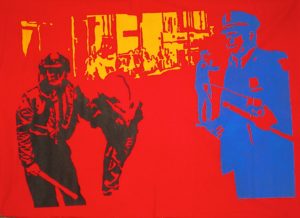
One of Warhol’s earliest prints is the Birmingham Race Riot of 1964, a news photo in black and white printed in high contrast. But in Memphis Riot Scene of 1968 Kent has arranged several images taken from newspapers in bright contrasting colors that emphasize the harsh reality of Martin Luther King’s assassination.
On May 25, 1961, President John F. Kennedy delivered a speech before a Joint Session of Congress where he called for the nation to “commit itself to achieving the goal, before this decade is out, of landing a man on the moon and returning him safely to the earth.” But Kent, ardent about protecting the environment, was worried that man would only spoil the moon as he had the earth. In 1964, his feelings were underscored by the passing of Rachel Carson, the author of the best-selling, Silent Spring, who had so effectively raised public awareness of environmental pollution. Plus, America was still reeling from the Kennedy assassination, race riots, and President Lyndon B. Johnson’s decision to begin bombing North Vietnam. It was within this context that Kent was angered by a Congressionally supported multi-billion dollar trip to the moon that he saw as funded by taxpayers yet benefiting major corporations. That anger was expressed in Leave the Moon Alone! (1964), created five years before the first lunar landing. Kent places an ominous warning at lower left in the form of the Egyptian goddess of the moon, Bastet, also the cat-goddess. Meanwhile, at the far right side of the image preparations are underway with a figure at upper right mapping a route to the moon while below him are rockets and astronauts.

By the mid 1960s Warhol’s reputation had grown owing to his unique style of portraiture (Marilyn, Liz, Elvis et al). But it was not until the 1969 exhibition of his Campbell Soup Can series at Castelli that his name became a household word. By that time Warhol had produced twenty-two editions. Kent had produced ninety-five series of monoprints.
During the 1970s Warhol continued to produce screenprints of celebrities such as Mick Jagger and Muhammad Ali and politicians such as Nixon, Carter, and Mao. Vote McGovern, his devilish portrait of Nixon, is based on a photojournalist’s headshot of the condemned president. This darkened visage is one of the few Warhol images that elicit an emotion in the viewer: fear. Kent chose an entirely different approach. His Nixon as an American Eagle (1975) is a wrathful assessment of a disgraced president who went up in flames. Kent supports his premise with the primordial wisdom fire associated with Buddhist deities, seen in the process of consuming the president.
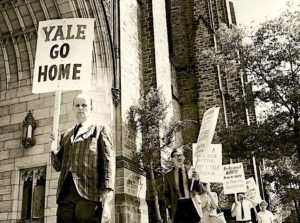
Kent did not express his political views exclusively through his prints. He was an activist, too. In the summer of 1964 he helped the Professional Artists of Connecticut organize a picket to protest the New Haven Festival of the Arts. The group urged a boycott because they claimed that the Yale School of Art worked behind the scenes to exclude all of the state’s art clubs and professionals in favor of promoting its art students and amateurs. His print commemorating the event is called Society Ladies with Two Right Hands. The Festival’s organizing committee finally relented and the show drew more than 150,000 visitors. Kent’s placards remained propped in his studio barn as proud testimony.
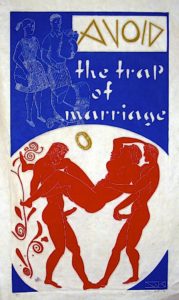
While Kent’s four-year run of shows at Castellane regularly drew positive reviews in the major art periodicals, none of the critics could neatly categorize his work. His biting sarcasm made satire look polite. His colors popped in contrast to their ground of printed patterned fabrics. And his technical prowess was never doubted. Artist and critic Donald Judd applauded their “ambiguity and visual interest” and another critic even noted that his work was “remarkable for both its craftsmanship and its spooky emotional power.” The success of Kent’s strident imagery, illuminated in New York, led to an unexpected and undesirable denouement. One day in 1965 a few women from the Paint & Clay Club were snooping about the artist’s basement studio and were suddenly shocked. They discovered impressions of Kent’s erotica monoprints such as The Day the One Escaped from the Zoo in which a female carries off a huge phallus. But in showing a housewife triumphant with the phallus of her castrated husband, was Kent a harbinger of the emergence of the women’s liberation movement? The women were equally appalled by Avoid the Trap of Marriage in which two men sporting erections carry off a woman. Alarmed by what appeared to be a collection of pornographic images, they rushed to the trustees of the Ely House. Kent was summoned before the board. He explained that he had a solo exhibition at the Castellane Gallery called “Erotic and Patriotic Prints of Sex and Violence.” He clarified that while his images served to spoof American attitudes on sex they also tapped the erotica found on ancient Greek black figure pottery exhibited in museums. In addition, he described how erotica had always symbolized the generative power of nature. Surprisingly, the several trustees never actually saw any of the condemned prints. Nevertheless, they quickly determined that their curator was a liability. He was promptly fired.
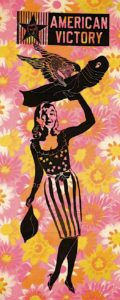
To make matters worse, in 1966 Castellane closed his gallery in favor of pursing a practice in law. That left Kent without a gallery. But this self-proclaimed irascible character was repulsed by the prospect of having to knock on gallery doors, portfolio in hand. Withdrawing from New York altogether, he returned to the bucolic hills of Durham, twenty miles northeast of New Haven, a village still largely dedicated to farming. In 1964, at age forty-five, he had purchased a small farmhouse that had the advantage of a large studio. He housed his growing population of sculptures and his collection slates in a capacious old chicken barn. Reflecting on the importance of galleries he said, “When you are in any New York gallery all the doors are open to you. I showed at the Whitney at that time in their annual… the Brooklyn Museum, Pennsylvania Academy. They go through dealers. If you’re not with a dealer you don’t exist. That’s the system.” Increasingly angry about the “system” required for gaining recognition, he decided instead to simply focus on the creation of art. That focus resulted in a large collection of provocative slate monoprints, the last of which was pulled in 1976. Reflecting in 2004 he wrote, “The so-called ‘art experts’ have rejected me for years saying that my work was unsalable — too angry, too political. I think with what is going on in Washington, people should be angry.”
Toward the end of the 1960s the spirited community of artists in Westbrook began to disperse, moving on to careers in the arts. Some of the musicians became prominent in symphony orchestras. Kent found himself increasingly isolated and monastic but carried on a rigorous schedule of carving. Focused and undeterred by the lack of a broad audience, and with only a few supportive collectors, he supported himself until 1982 by working at a paper box company where he designed cardboard boxes with inventive folding configurations. “There is no safety net in the New York art world,” he wryly commented. As the years passed his regimen began with carving from early morning to early afternoon, then reading philosophy and literature and playing the piano. He tired of the occasional reporter discovering him only to label him a recluse, a hermit, and a curmudgeon. He was even accused of purposely hiding his work. “I think part of the problem is that the people who run these art institutions are on the whole managerial types. Very uncreative minds. They are so afraid of showing BAD ART that they stick to the accredited and officially approved art styles out of the commercial New York City fine arts world.”
Feeling as if he had exhausted two-dimensional image making, in 1977 Kent returned to sculpture and focused his considerable energy on creating what would become a forest of brilliantly carved wooden sculptures. Warhol, however, redoubled his printmaking through the 1980s and was engaged by his print publishers to produce a lucrative series of portfolios, including Jews of the Twentieth Century, Myths, Endangered Species, Reigning Queens, Ads, and Cowboys and Indians. Kent felt justifiably proud in having been effectively censored for avoiding what he saw as a stylistic morass motivated by commercialism.
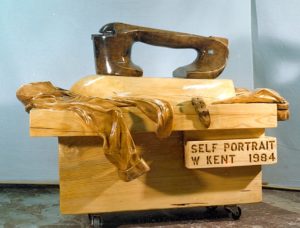
When Kent returned to carving wood in 1977, political or social themes were still on his mind — only from this point on his sculptures were consistently large. The military-industrial complex became the brunt of an early attack with his D. Duck No.1 as American Eagle on Trash Can on Snow Tires (1978, 67.5 inches) and D. Duck No.2 Holding Wrench on a Steamroller (1978, 84 inches). Self-portraiture remained a constant theme with Self-Portrait of Artist with Iron (1984, 63 inches). Sex, too, was parodied in the huge functioning Battering Ram (Fuck Machine) (1985, 84 inches). He also found delight in turning simple everyday objects into monumental sculptures. These included crushed milk cartons, crushed beer cans, faucets, shoehorns, false teeth, scissors, pliers, clamps, wrenches, and electric plugs. In the 1960s the Pop sculptor Claes Oldenberg had also begun to enlarge everyday objects except his forms were typically soft. Kent never paid much attention to the younger artist’s works. (Oldenberg had entered Yale in 1947, the same year Kent graduated, but the two never met.)
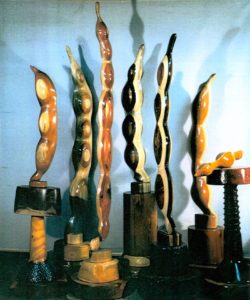
For Kent the objective of his large carvings was never to deliver a one-liner joke. Rather, he consistently paid great attention to creating highly finished objects and integrating them with their carved bases. For example, his Hot Water Bottle No.1 (1994, 75 inches) features a common hot water bottle placed in an exalted position high atop a base that is a modern ziggurat of tapered stages looking as if it could have come from the studio of one of Kent’s favorite sculptors, Brancusi. Kent also produced a series of twenty-seven shell beans during the 1990s — tall and elegant totemic forms that reflect his own sophisticated sense of formalism even when glorifying a simple vegetable. Grouped together in the barn, this series reinforces the sense of a perfectly finished and glistening forest.
One of the critics who recognized his importance was Alan Bisbort, who wrote two articles on Kent that appeared in The New York Times. A letter from Kent to Bisbort is worth reproducing in full because it illustrates the artist’s dismissive opinion about Warhol and the next wave of emerging artists:
I greatly enjoyed your well-written article on Alice Neel.
Consider: At the same time Andy Warhol was doing those glitzy, superficial, mediocre portraits of Liz and Elvis and all the other media heroes. They became the height of fashion in the N.Y. art world. Neel was painting beautiful, accomplished, and penetrating portraits, which were as you wrote largely ignored in their time. Time will adjust eventually. But what a shame for the self-appointed “art experts” of her time.
Now we have a new generation who are making the same mistakes!
Best wishes,
Bill Kent
7-20-00
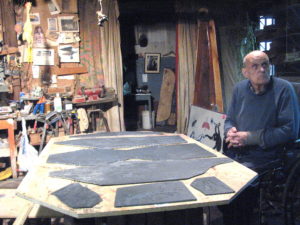
In 2006 Kent suffered from a circulatory disease that required the amputation of his right leg. Undeterred, he quickly returned to complete his carving of another monumental shoehorn, Shoehorn No.10, and continued producing large sculptures at the rate of about three to four a year. The word disability never existed in his vocabulary. He never expressed any anger or regret over being bound to a wheelchair. Indeed, his youthful energy remained undiminished. He was more like a force of nature that had chosen a chicken barn as the microcosm in which he was destined to carve unique and compelling expressions in wood — and pull provocative images from his carved slates. It was as if that barn held a unique life energy, one from which he refused to be separated even when he was in dire need of hospitalization. Day after day he still labored his way to the studio to carve. One day during the last month of his life his health suddenly turned for the worse. When the ambulance arrived the 93-year-old adamantly refused to leave.
Ultimately, Kent’s life story invokes the question, “Why do some of art history’s most innovative masters go unrecognized?” He only briefly flirted with the advantage of being accepted in New York. Instead of being either “intsider” or “outsider,” he remained inside-out, surging ahead in a weird philosophical inter-zone where recognition in an art world that could have brought him fame was always as much a hope as it was regarded with suspicion and antagonism.
— Peter Hastings Falk
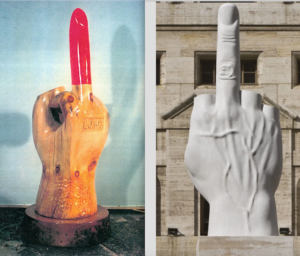
Footnotes
1 When Kent inquired about his sculpture years later, he was surprised and dismayed that it was not documented as part of Dreier’s Société Anonyme collection at Yale. Dreier had sent her collection to Yale seven years earlier, in 1941, but it was on loan because she was still trying to raise funds to turn her then Redding home into a museum for the collection. Meanwhile, she continued to purchase art and add to her collection. In 1947 she attempted to reopen membership to the Société Anonyme and printed a brochure, but Yale refused to allow its name on it and blocked distribution. Adding to the friction, she was unsuccessful in raising the funds to create her own museum. In 1948 Dreier got Duchamp to help her create a catalog of the collection, and this is the year she met William Kent.

Bibliography
Eichenberg, Fritz. The Art of the Print (New York: Abrams, 1976, p.156-157)
Falk, Peter Hastings. Who Was Who in American Art (Madison, Conn: Sound View Press, 1999)
Falk, Peter Hastings. The Annual & Biennial Exhibition Record of the Whitney Museum of American Art: 1918-1989 (Madison, Conn: Sound View Press, 1991) [1966, item no. 25: Leave the Moon Alone! (monoprint)]
Falk, Peter Hastings. The Annual Exhibition Record of the Pennsylvania Academy of the Fine Arts, Vol III (Madison, Conn: Sound View Press, 1989) [1964, item no. 152: Mercury of Trumbull Street a.k.a. Nature Lover No.5, 1962 (wood sculpture)]
Fike, Bonita. The Fine Art of Wood: Bohlen Collection. (Detroit Institute of Arts: 2000, p.74, 131)
Kent, William. William Kent: Stonecarvings, 1951-1955. (New Haven, Conn: privately published, 1956)
Kent, William. The Dime Store: In Fifty Counters. (New Haven, Conn: Philistine Press, 1957? With poems by Kent illustrated with 22 drawings by William Skardon, 52pp)
Kent, William. William Kent: Carvings, 1948-1960. (New Haven, Conn: Philistine Press, 1960; 172 pp with 257 halftone illustrations)
Lippard, Lucy. Pop Art (New York: Thames & Hudson, 1966, p. 137).
McVaugh, Robert. Pop Art with Social Pop: Slate Prints by William Kent. (Hamilton, New York: Colgate University: The Picker Art Gallery, 1997)

Collections
Yale University Art Gallery purchased George Washington (1966) 78 x 43 inches in 2004
[“Your political prints pack a powerful punch.” Jock Reynolds, Director]
Colgate University: The Picker Art Gallery.

Select Exhibitions
Brooklyn Museum
De Cordova Museum and Sculpture Park, Lincoln, Mass.
Colgate University: The Picker Art Gallery, “Pop Art with Social Pop: Slate Prints by William Kent” (1997)
Detroit Institute of Arts
Kalamazoo Institute of Arts
Memorial Art Gallery of the University of Rochester, New York.
Renwick Gallery of the National Museum of American Art, Smithsonian Institution, Washington, D.C.
Whitney Museum of American Art, New York: Annual Exhibition, 1966.

